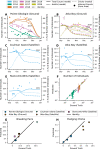Remote sensing of emperor penguin abundance and breeding success
- PMID: 38811565
- PMCID: PMC11137044
- DOI: 10.1038/s41467-024-48239-8
Remote sensing of emperor penguin abundance and breeding success
Abstract
Emperor penguins (Aptenodytes forsteri) are under increasing environmental pressure. Monitoring colony size and population trends of this Antarctic seabird relies primarily on satellite imagery recorded near the end of the breeding season, when light conditions levels are sufficient to capture images, but colony occupancy is highly variable. To correct population estimates for this variability, we develop a phenological model that can predict the number of breeding pairs and fledging chicks, as well as key phenological events such as arrival, hatching and foraging times, from as few as six data points from a single season. The ability to extrapolate occupancy from sparse data makes the model particularly useful for monitoring remotely sensed animal colonies where ground-based population estimates are rare or unavailable.
© 2024. The Author(s).
Conflict of interest statement
The authors declare no competing interests.
Figures








References
-
- Forcada, J. & Trathan, P. N. Penguin responses to climate change in the southern ocean. Glob. Change Biol. 15, 1618–1630 (2009).
-
- Jenouvrier S, et al. Projected continent-wide declines of the emperor penguin under climate change. Nat. Clim. Change. 2014;4:715–718. doi: 10.1038/nclimate2280. - DOI
-
- Fretwell PT, Trathan PN. Discovery of new colonies by sentinel2 reveals good and bad news for emperor penguins. Remote Sens. Ecol. Conserv. 2020;7:139–153.
MeSH terms
Grants and funding
LinkOut - more resources
Full Text Sources

